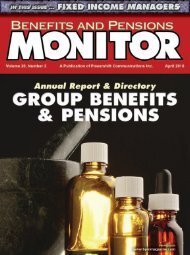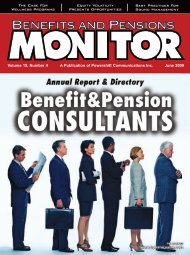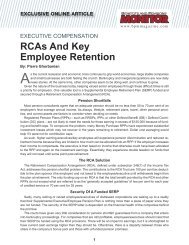BPM October 2010.indd - Benefits and Pensions Monitor
BPM October 2010.indd - Benefits and Pensions Monitor
BPM October 2010.indd - Benefits and Pensions Monitor
You also want an ePaper? Increase the reach of your titles
YUMPU automatically turns print PDFs into web optimized ePapers that Google loves.
1<br />
Governing Capital Accumulation Plans In 2010<br />
Michelle A.<br />
Loder<br />
Canadian Defi ned<br />
Contribution Leader,<br />
Towers Watson<br />
Canada Inc.<br />
A Renewed Focus<br />
For Capital Accumulation Plans<br />
Governance:<br />
SPONSORED SECTION<br />
Mark Newton Joan Johannson Ron Sinnaeve Deborah Marc Poupart<br />
Partner & National<br />
Practice Leader,<br />
Pension &<br />
Benefi ts Law,<br />
Heenan Blaikie LLP<br />
Each year as more <strong>and</strong> more<br />
traditional Defi ned Benefi t pension<br />
plans are frozen <strong>and</strong> closed<br />
to new members, the need for<br />
Capital Accumulation Plans to replace<br />
them as an attraction <strong>and</strong> retention tool<br />
grows.<br />
Yet, CAP plans are facing new challenges<br />
in the wake of rocky fi nancial markets<br />
which drained many Canadians of<br />
their retirement savings <strong>and</strong> exacerbated<br />
the traditional challenge of engaging plan<br />
members.<br />
Joining education <strong>and</strong> information in<br />
President,<br />
BMO Group<br />
Retirement<br />
Services Inc.<br />
MODERATOR: Are the primary reasons for starting,<br />
or changing to, a Defi ned Contribution pension<br />
plan in the past – providing an employee benefi t<br />
<strong>and</strong> cost control – still true today?<br />
MARK NEWTON: The fundamental reasons have changed.<br />
Retirement savings, whether DB or DC, are a fundamental part of<br />
the overall compensation package.<br />
What has happened in the Canadian marketplace is that DC<br />
has moved from being a secondary vehicle. It is now the primary<br />
vehicle. That changes the whole emphasis. The way you communicate<br />
a plan <strong>and</strong> the delivery of a plan are quite a bit different.<br />
There’s a different mindset among employees, at least within the<br />
private sector.<br />
The fundamental objective, to provide retirement savings in a<br />
tax effective basis, is the same as it was 25 years ago. The vehicles<br />
have just changed.<br />
MARC POUPART: Another historic reason was to provide<br />
members with more latitude to do what they want. It’s funny, years<br />
ago, the expected returns from markets were probably higher than<br />
Director,<br />
Administration &<br />
Business Solutions,<br />
BMO Group Retirement<br />
Services Inc.<br />
the toolbox plan sponsors use to manage<br />
their plans is governance. This new<br />
emphasis on governance is fuelled in part<br />
by the responsibility sponsors feel to provide<br />
retirement savings for their members<br />
<strong>and</strong> the growing realization that what they<br />
do in terms of managing the plan can,<br />
in fact, assist plan members in reaching<br />
their retirement goals.<br />
To examine their renewed emphasis on<br />
governance, Joan Johannson, president,<br />
<strong>and</strong> Ron Sinnaeve, director, administration<br />
<strong>and</strong> business solutions, of BMO Group<br />
Retirement Services Inc., hosted a round-<br />
Beesley<br />
Payroll & Benefi ts<br />
Financial Specialist,<br />
CNA Canada,<br />
Continental Casualty<br />
Company<br />
®<br />
General Manager,<br />
Pension & Retirement<br />
Programs,<br />
Hudson’s Bay<br />
Company<br />
table discussion on governance of Capital<br />
Accumulation Plans in 2010.<br />
The panelists are Michelle A. Loder,<br />
Canadian Defi ned Contribution leader,<br />
Towers Watson Canada Inc.; Mark Newton,<br />
a partner <strong>and</strong> national practice leader<br />
in pension law at Heenan Blaikie LLP;<br />
Marc Poupart, general manager, pension<br />
<strong>and</strong> retirement programs, Hudson’s Bay<br />
Company; <strong>and</strong> Deborah Beesley, payroll<br />
<strong>and</strong> benefi ts fi nancial specialist, CNA<br />
Canada, Continental Casualty Company.<br />
Joe Hornyak, executive editor, Benefi ts<br />
<strong>and</strong> Pension <strong>Monitor</strong>, is the moderator.<br />
what we have today, so it was viewed as an opportunity shift, not<br />
a cost reduction.<br />
Today, I would suggest that is probably not the case. Sponsors<br />
see Defi ned Benefi t pension plan costs as ‘out of control.’ So let’s<br />
control that <strong>and</strong> DC is one way to control it.<br />
DEBORAH BEESLEY: From a plan perspective or a plan<br />
sponsor perspective, we now have a more mobile workforce. DB<br />
is more complimentary to longer service employees. With a workforce<br />
with a shorter term, they’re taking their benefi t with them,<br />
that would be another reason for going to a DC plan.<br />
As well, funding on the budgeting side is so much easier to manage<br />
<strong>and</strong> predict.<br />
MODERATOR: Are there any other compelling<br />
arguments for starting or switching to a DC plan<br />
today?<br />
MICHELLE LODER: A survey we did this year found many<br />
reasons.<br />
Certainly the most often cited reason, by far, was for competi-









